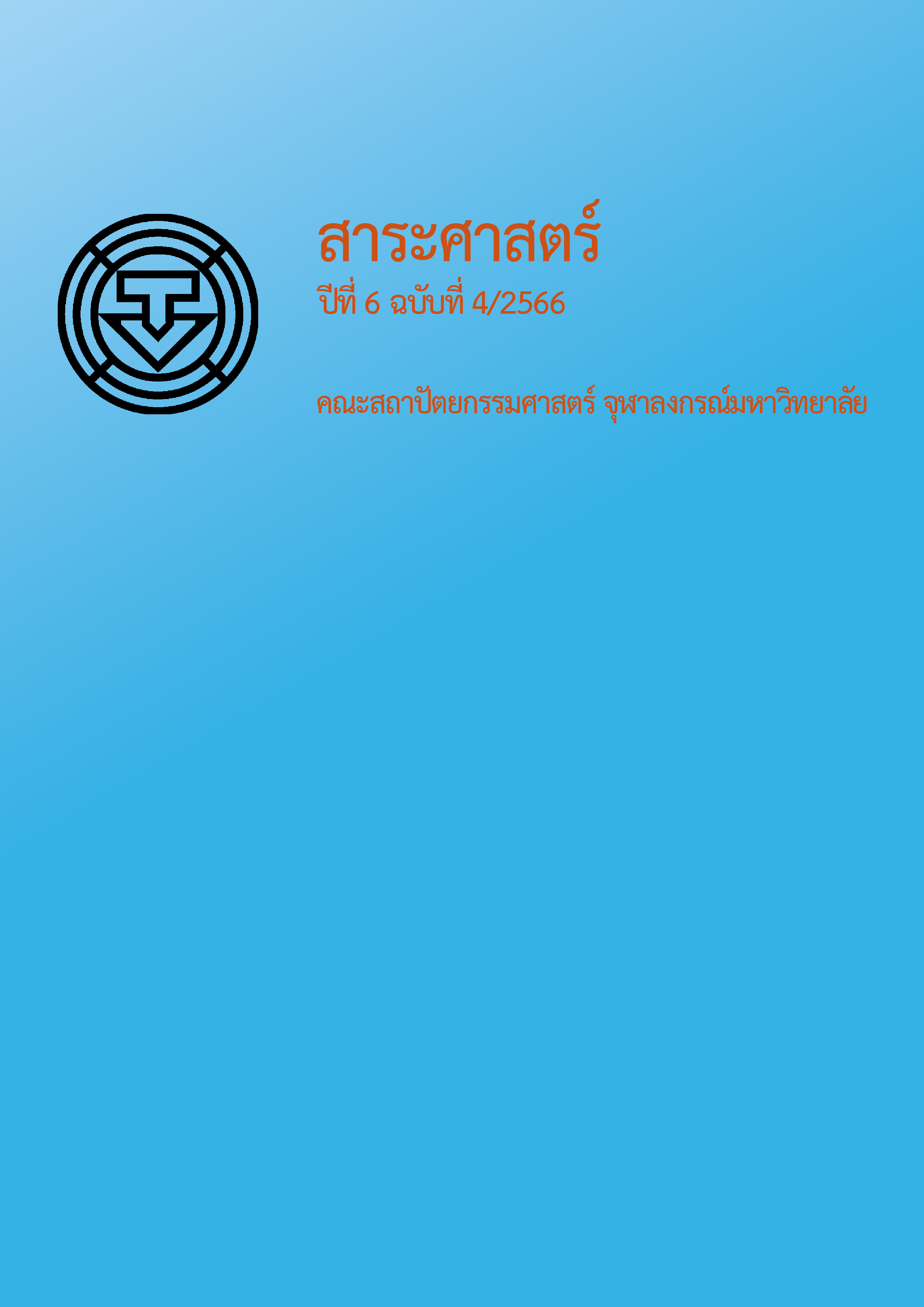The Change of Land Space Utilization after the Construction of Flood Protection Dike: A Case Study of Paknampho Subdistrict, Nakhon Sawan
Main Article Content
Abstract
This research aims to 1) explore the impacts of flood protection dikes at Paknampho subdistrict, Nakhon Sawan toward its flood protection efficiency and toward people’s confidence in flood protection, 2) explore the impacts of flood protection dikes on people's activities and 3) study the impacts of flood protection dike on people's place attachment in order to provide recommendations for physical improvements on the area along the flood protection dike. The research process includes selecting a study area with apparent physical changes as well as collecting data using observations, Post-Occupancy Evaluations (POE), interviews, and questionnaires in order to collect data on users’ activities, space utilizations, and attitudes toward sense of place.
The results revealed that the construction of flood protection dike can protect severe flooding. Also, people in the area have a high level of confidence in the flood protection. The construction of flood protection dike also leads to a wider variety of activities. However, there is a decrease in the number of users and boat traffic. The flood protection dike raised an awareness of the importance of the river. On the other hand, it creates a visual blind spot between the city and the river and reduces the aesthetic value of the river. In addition, those who live in the area or have been living for a long time have a greater attachment to the river. This is due to their experiences with the community way of life.
Article Details
References
กรมชลประทาน. (จากข่าว Thai PBS) (2565). เทียบสถิติลุ่มน้ำเจ้าพระยาปี 54-65 ใกล้จุดวิกฤตหรือไม่. https://www.thaipbs.or.th/news/content/320348
กรมชลประทาน. ศูนย์ปฏิบัติการน้ำอัจฉริยะ. (2565). สรุปสถานการณ์อุทกภัยปี 2565 ประจำวันที่ 19 ธันวาคม ปี 2565 เวลา 08.00 น. http://www.water.rid.go.th/flood/news/สรุปสถานการณ์อุทกภัย%2019-12-65%20เวลา% 2008.00%20น.pdf
กรมโยธาธิการและผังเมือง. (2551). แนวทางการแก้ไขปัญหา อุปสรรค การออกแบบและก่อสร้างระบบป้องกันน้ำท่วมพื้นที่ชุมชน. สำนักสนับสนุนและพัฒนาตามผังเมือง. http://subsites.dpt.go.th/edocument/images/pdf/doc_work/modify_flood.pdf
ดนัย นิลสกุล และนพดล ตั้งสกุล. (2559). สำนึกในถิ่นที่ในย่านการค้าเก่าเมืองอุบลราชธานี. การประชุมวิชาการทางสรรค์สถาปัตยกรรมสาระสถาปัตยกรรมพื้นถิ่นและสภาพแวดล้อมทางวัฒนธรรม (น. 180-195). คณะสถาปัตยกรรมศาสตร์ มหาวิทยาลัยขอนแก่น.
เทศบาลนครนครสวรรค์. (2555). วิธีการป้องกันปัญหาน้ำท่วมของเทศบาลนครนครสวรรค์ในอดีต. การอบรมเรื่อง การป้องกันปัญหาน้ำท่วม. เทศบาล.
แพรวศร ดีใจวงษ์. (2556). การประเมินผลกระทบจากโครงการเขื่อนป้องกันน้ำท่วมริมตลิ่งบริเวณพื้นที่ริมแม่น้ำปิงและแม่น้ำเจ้าพระยา ตำบลปากน้ำโพ เทศบาลนครนครสวรรค์ จังหวัดนครสรรค์ [วิทยานิพนธ์ปริญญามหาบัณฑิต ไม่ได้ตีพิมพ์]. มหาวิทยาลัยศิลปากร.
เมธา คล้ายแก้ว. (2548). การศึกษาพฤติกรรมการใช้พื้นที่ริมแม่น้ำเพื่อออกแบบปรับปรุงการใช้สอยพื้นที่และภูมิทัศน์ กรณีศึกษา : ตลาดริมแม่น้ำเจ้าพระยา ต.ปากน้ำโพ อ.เมือง จ.นครสวรรค์ [วิทยานิพนธ์ปริญญามหาบัณฑิต ไม่ได้ตีพิมพ์]. มหาวิทยาลัยศิลปากร.
สถาบันสารสนเทศทรัพยากรน้ำ (องค์การมหาชน). คลังข้อมูลน้ำและภูมิอากาศแห่งชาติ. (2565). สถานีสำรวจปริมาณน้ำท่า. https://tiwrm.hii.or.th/DATA/REPORT/php/itc_zcgraph.php?id1=35
สถาบันสารสนเทศทรัพยากรน้ำและการเกษตร. (2557). บันทึกเหตุการณ์ภัยแล้ง ปี 2556/2557. https://tiwrm.hii.or.th/current/drought57/drought57.html
สินีนาถ ศุกลรัตนเมธี. (2558, มกราคม-ธันวาคม). องค์ประกอบในการออกแบบสภาพแวดล้อมที่ช่วยส่งเสริมความรู้สึกเป็นส่วนหนึ่งของชุมชน. วารสารหน้าจั่วสถาปัตยกรรม การออกแบบ และสภาพแวดล้อม, 29, 477-488.
Deutsch, K., & Goulias, K. (2009). Investigating the impact of sense of place on travel behavior using an intercept survey methodology. University of California Transportation Center, UC Berkeley.
Jacob, J. (1994). The death and life of Great American cities. Vintage Books.
Hay, B. (1998). Sense of place in developmental context. Journal of Environmental Psychology, 18(1), 5-29.
Levison, D. J., Darrow, C. N., Kleun, E. B., Levison, M. H., & Mckee, B. (1978). The seasons of a man’s life. Academic Press.
Lewicka, M. (2011). On the varieties of people’s relationships with place: Hummon’s typology revisited. Environment and Behavior, 43(5), 676-709.
Mulvaney, K., Merrill N. H., & Mazzotta M. J. (2020). Sense of place and water quality: Applying sense of place metrics to better understand community impacts of change in water quality. In Kevin Summers (Ed.), Water quality – Science, assessments, and policy (pp. 21-34). Intechopen.
Relph, E. (1976). Place and place lessness. Pion.
Shamai, S. (1991). Sense of place: An empirical measurement. Geoforum, 22(3), 347-358.
Stedman, R. C. (2002, September). Toward a social psychology of place: Predicting behavior from place-based cognitions, attitude, and identity. Environment and Behavior, 34(5), 561-581.
Tiedsell, S., & Oc, T. (1998). Beyond ‘fortress’ and ‘panoptic’ cities--Towards a safer urban public realm. Environment and Planning B: Planning and Design, 25(5), 639-655.


